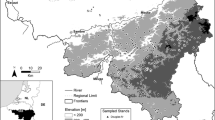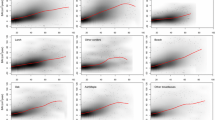Abstract
A two-stage modelling approach was used for developing ingrowth models for four major tree species in Alberta: aspen, lodgepole pine, black spruce and white spruce. The probability of ingrowth presence was modelled first, followed by the modelling of annual amount of ingrowth conditional on ingrowth being present. To handle variable measurement intervals and plot sizes typical of repeatedly measured forestry data, two generalized logistic models were evaluated at the first stage: a traditional model with measurement interval length and plot size factor incorporated as an exponent of a standard logistic function and an alternative model with measurement interval length and plot size factor incorporated as a denominator. Two criteria were evaluated for defining optimal threshold values for plot classification: criterion 1 to maximize the summation of sensitivity and specificity and criterion 2 to maximize the overall rate of correct plot classification. It was found that criterion 1 was superior to criterion 2 for providing better plot classifications. The two ingrowth probability models behaved similarly based on model fitting and model validation results. Annual amount of ingrowth was modelled at the second stage by exponential functions.




Similar content being viewed by others
References
Adame P, Del Río M, Caňellas I (2010) Ingrowth model for pyrenean oak stands in north-western Spain using continuous forest inventory data. Eur J For Res 129:669–678
ASRD (2005) Permanent sample plot (PSP) field procedures manual. Forest Management Branch, Alberta Sustainable Resource Development, Edmonton
Beers TW (1962) Components of forest growth. J For 60:245–248
Bravo F, Pando V, Ordóñez C, Lizarralde I (2008) Modelling ingrowth in Mediterranean pine forests: a case study from scots pine (Pinus sylvestris L.) and Mediterranean maritime pine (Pinus pinaster Ait.) stands in Spain. Investigación Agraria: Sistemas y Recursos Forestales 17(3):250–260
Burk TE (1978) Characterizing the growth dynamics of Lake States aspen. M.S. Thesis, Univ. of Minnesota, St. Paul
Cochran WG (1963) Sampling techniques, 2nd edn. Wiley, New York
Cunningham RB, Lindenmayer DB (2005) Modeling count data of rare species: some statistical issues. Ecology 86:1135–1142
Ek AR (1974) Nonlinear models for stand table projection in northern hardwood stands. Can J For Res 4(1):23–27
Ferguson DE, Stage AR, Boyd RJ (1986) Predicting regeneration in the grand fir-cedar-hemlock ecosystem of the northern rocky mountains. For Sci Monogr 26:41
Fortin M, DeBlois J (2007) Modeling tree recruitment with zero-inflated models: the example of hardwood stands in southern Québec, Canada. For Sci 53:529–539
Fortin M, Bédard S, DeBlois J, Meunier S (2008) Predicting individual tree mortality in northern hardwood stands under uneven-aged management in southern Québec, Canada. Ann For Sci 65(2):205
Hamilton DA, Brickell JE (1983) Modeling methods for a two-state system with continuous responses. Can J For Res 13:1117–1121
Hann DW (1980) Development and evaluation of an even- and uneven-aged ponderosa pine/Arizona fescues stand simulator. USDA For Serv Res Pap INT-267
Hosmer DW, Lemeshow S (2000) Applied logistic regression, 2nd edn. Wiley, New York
Huang S, Meng SX, Yang Y (2009) Assessing the goodness of fit of forest models estimated by nonlinear mixed-model methods. Can J For Res 39:2418–2436
Klopcic M, Poljanec A, Boncina A (2012) Modelling natural recruitment of European beech (Fagus sylvatica L.). For Ecol Manag 284:142–151
Lexerod N (2005) Recruitment models for different tree species in Norway. For Ecol Manag 206:91–108
Lexerød N, Eid T (2005) Recruitment models for Norway spruce, scots pine, birch and other broadleaves in young growth forests in Norway. Silva Fenn 39:391–406
Li R, Weiskittel AR, Kershaw JA (2011) Modeling annualized occurrence, frequency, and composition of ingrowth using mixed-effects zero-inflated models and permanent plots in the Acadian Forest Region of North America. Can J For Res 41:2077–2089
Monserud RA (1976) Simulation of forest tree mortality. For Sci 22:438–444
Moser JW (1972) Dynamics of uneven-aged forest stands. For Sci 18:184–191
Muhairwe, CK (2003) Biometric models. Nandewar bio-region. NSW Western Regional Assessments. Projection no.: NAND 08 (vol 5). Resource and Conservation Assessment Council
Neter J, Wasserman W, Kutner MH (1989) Applied linear regression models, 2nd edn. Irwin, Boston
Qin Y (1998) Ingrowth models and juvenile mixedwood stand dynamics. Dissertation, University of Alberta
Shifley SR, Ek AR, Burk TE (1993) A generalized methodology for estimating forest ingrowth at multiple threshold diameters. For Sci 39(4):776–798
Soureshjani MH, Kimiagari AM (2013) Calculating the best cut off point using logistic regression and neural network on credit scoring problem—a case study of a commercial bank. Afr J Bus Manag 7(16):1414–1421
Trasobares A, Pukkala T, Miina J (2004) Growth and yield model for uneven-aged mixtures of Pinus sylvestris L. and Pinus nigra Arn. in Catalonia, north-east Spain. Ann For Sci 61:9–24
Vanclay JK (1989) A growth model for North Queensland rainforests. For Ecol Manag 27:245–271
Vanclay JK (1992) Modelling regeneration and recruitment in a tropical forest. Can J For Res 22:1235–1248
Vanclay JK (1994) Modelling forest growth and yield: applications to mixed tropical forests. CAB International, Wallingford
Vanclay JK (2014) Unsuspected implications arising from assumptions in simulations: insights from recasting a forest growth model in system dynamics. For Ecosyst 1(7):1–10
Yang Y, Huang S (2008) Modeling percent stocking changes for lodgepole pine stands in Alberta. Can J For Res 38:1042–1052
Yang Y, Huang S (2013) A generalized mixed logistic model for predicting individual tree survival probability with unequal measurement intervals. For Sci 59(2):177–187
Yao X, Titus SJ, Macdonald SE (2001) A generalized logistic model of individual tree mortality for aspen, white spruce, and lodgepole pine in Alberta mixedwood forests. Can J For Res 31:283–291
Author information
Authors and Affiliations
Corresponding author
Additional information
Communicated by Arne Nothdurft.
Rights and permissions
About this article
Cite this article
Yang, Y., Huang, S. Two-stage ingrowth models for four major tree species in Alberta. Eur J Forest Res 134, 991–1004 (2015). https://doi.org/10.1007/s10342-015-0904-0
Received:
Revised:
Accepted:
Published:
Issue Date:
DOI: https://doi.org/10.1007/s10342-015-0904-0




